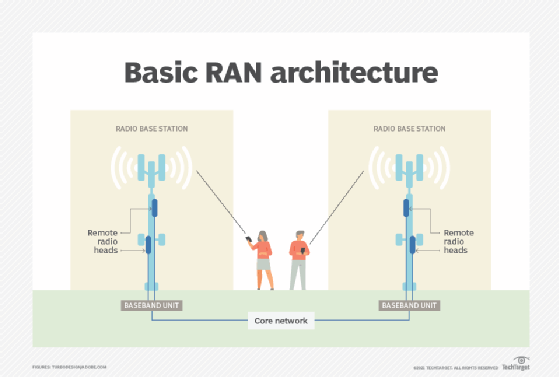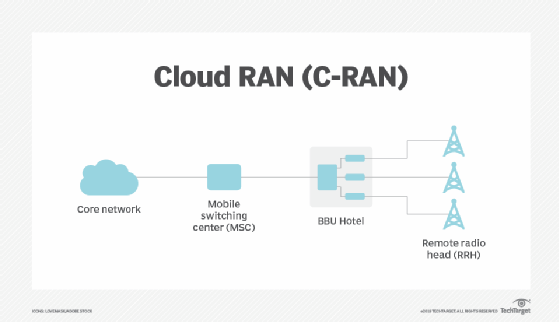radio access network (RAN)
What is radio access network?
A radio access network (RAN) is a major component of a wireless telecommunications system that connects individual devices to other parts of a network through a radio link. The RAN links user equipment, such as a cellphone, computer or any remotely controlled machine, over a fiber or wireless backhaul connection. That link goes to the core network, which manages subscriber information, location and more.
The RAN, which is sometimes also called the access network, is the radio element of the cellular network. A cellular network is made up of land areas called cells. A cell is served by at least one radio transceiver, although the standard is typically three for cell sites.
RANs have evolved from the first generation (1G) to the fifth generation (5G) of cellular networking. With the development of fourth generation (4G) technology in the 2000s, the 3rd Generation Partnership Project introduced Long-Term Evolution (LTE) RAN, and the radio access network and the core network changed significantly. With 4G, system connectivity for the first time was based on the Internet Protocol (IP), replacing the previous circuit-based networks.
Now, with LTE Advanced and 5G, improvements are coming in the form of centralized RAN, also called cloud RAN (C-RAN), and multiple antenna arrays, such as multiple input, multiple output (MIMO).
Since the first cellular networks were introduced, the capabilities of RAN have expanded to include voice calls, text messaging, and video and audio streaming. The types of user equipment using these networks have drastically increased, including all types of vehicles, drones and internet of things devices.
What components make up a RAN?
RAN components include base stations and antennas that cover a specific region, depending on their capacity. Silicon chips in both the core network and the user equipment provide RAN functionality.
A RAN is made up of three essential elements:
- Antennas convert electrical signals into radio waves.
- Radios transform digital information into signals that can be sent wirelessly and ensure that transmissions are in the correct frequency bands with the right power levels.
- Baseband units (BBUs) provide a set of signal processing functions that make wireless communication possible. Traditional baseband uses custom electronics combined with multiple lines of code to enable wireless communication, typically using the licensed radio spectrum. BBU processing detects errors, secures the wireless signal and ensures that wireless resources are used effectively.

How does a RAN work?
A RAN provides access to and coordinates the management of resources across the radio sites. A handset or other device is wirelessly connected to the backbone, or core network, and the RAN sends its signal to various wireless endpoints so it can travel with traffic from other networks. A single handset or phone could be connected at the same time to multiple RANs, sometimes called dual-mode handsets.
In second generation (2G) and third generation (3G) RAN architecture, the RAN controller manages the nodes connected to it. The RAN's network controller -- which manages radio resources, mobility and data encryption -- connects to the circuit-switched core network and the packet-switched core network, depending on the type of RAN.
With the advent of 4G LTE and an all-IP network, the layout of the radio access network has changed. In particular, the introduction of C-RAN has split the radios and antennas from the baseband controller to adapt better to the modern demands of mobile devices.
Today, RAN architecture divides the user plane and the control plane into separate elements. The RAN controller can exchange one set of user data messages through a software-defined networking switch and a second set through a control-based interface. This separation enables the RAN to be more flexible, accommodating the network functions virtualization techniques, such as network slicing and high MIMO, that are necessary for 5G.

What is RAN in 5G?
The 5G New Radio (5G NR) standard is the latest radio interface and radio access technology for 5G cellular technology. The interface supports multiple frequency bands, including sub-6 gigahertz bands and millimeter wave (mmWave) bands, such as 24 GHz, 28 GHz and higher. The mmWave bands offer 1+ gigabits per second download speeds, but they have reduced ranges compared to sub-6 GHz services.
Radio access network types
RAN trends include the following:
- Open RAN is the hot topic in the access network world. It involves developing interoperable open hardware, software and interfaces for cellular wireless networks that use white box servers and other standard equipment, rather than the custom-made hardware typically used in base stations.
- C-RAN separates the radio elements in a base station into remote radio heads (RRHs). These can be used atop the cell towers for the most efficient radio coverage. RRHs must be connected to centralized baseband controllers via fiber or microwave radio links. Most baseband processing uses standard white box servers.
- Global System for Mobile communications (GSM) RAN, or GRAN, was developed for 2G.
- GSM EDGE RAN, or GERAN is similar to GRAN, but it specifies the inclusion of Enhanced Data GSM Environment packet radio services.
- Universal Mobile Telecommunications System (UMTS) Terrestrial RAN, or UTRAN, came about with 3G.
- Evolved Universal Terrestrial RAN, or E-UTRAN, is part of LTE.
The evolution of RAN
1G cellular networks were launched in Tokyo in 1979, using analog radios and wireless technology. The first commercial cellular network in the U.S. was built in 1983. In 1991, a digital 2G GSM network was launched in Finland. Soon, cellular networks were launched worldwide, enabling people to transfer data and send text messages for the first time.
This triggered a split between the GSM and Code-Division Multiple Access (CDMA) standards. The GSM standard was developed by the European Telecommunications Standards Institute and used throughout the world. Qualcomm developed CDMA, and Sprint and Verizon predecessors used it in North America, as well as parts of South America, Japan and South Korea.
NTT DoCoMo commercially deployed 3G in 2001. UMTS is the GSM-based standard for 3G, while CDMA2000 was a rival standard. Mobile internet access became possible with 3G, which delivered a download speed of 6 megabits per second.
4G LTE service first launched between Oslo, Norway, and Stockholm, in December 2009. As previously mentioned, 4G LTE was the first major cellular network spec to use IP for all data packets, including voice. Beginning in 2013, as true 4G LTE Advanced was deployed, more C-RAN and MIMO antenna arrays became available.
5G NR began to rollout at the end of 2018 and continued into 2019 and 2020. The majority of 5G networks deployed to date are RAN networks that use a 4G core network to handle data sessions, although standalone 5G networks that function without a 4G base are starting to arrive.
More on 5G
Preparing an organization for the latest advances in wireless technology isn't easy. Learn more about how to plan for 5G, implement the technology and use it.
Enterprise 5G: Guide to planning, architecture and benefits
How to build a private 5G network architecture






